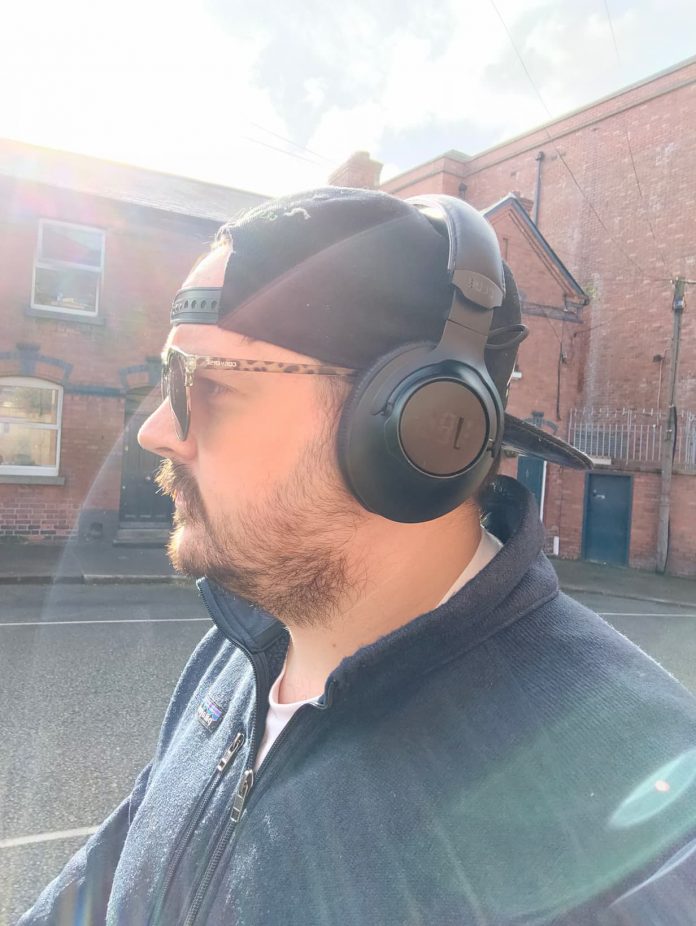When you get to review as many things as I do you have to challenge a lot of your own perceptions. Getting around brands is one of the toughest things. Big brand names can product terrible products while smaller brands can produce some incredible pieces of kit. There was a time when Huawei was a little-known phone manufacturer, in Europe at least, but today they’re a household name with the best smartphone cameras on the market. When the JBL Club One headphones landed on my desk, I didn’t expect much. In fact, I pushed the box to one side for a few days because the JBL brand didn’t excite me. When I opened the box, I learned the error of my ways.
Who Is JBL?
It’s my first time writing about JBL so let me take a moment to give you a quick history. I used to think JBL was just a logo slapped onto accessories but the company has a rich history. JBL is an American audio equipment company founded in 1946 and today is a sub-brand of Harman International. Samsung users will recognise that name as the brand which features on a lot of Samsung audio technology. JBL, to a certain extent, is a value brand. You generally don’t pay a huge amount of money for their headphones or speakers but you do get a very good experience in return. JBL sent me the Club One wireless headphones to test out and it’s an interesting start point when reviewing JBL products. It’s interesting because these are not aimed at value users. At €330, these are not aimed at value-seeking customers but hardcore audiophiles. Let’s take a look at them.
The JBL Club One
The JBL Club One are over-ear studio-grade headphones. This means in testing these I’m putting them up against the very best in the business. For me, that’s my long-standing favourites, the Bose QC35 II, the Sony WH-1000XM3 (and yet to be tested WH-1000XM4) and even the lacklustre Sennheiser Momentum 3 headphones. The last one here is interesting because they are similarly priced setting the Club One up with a tough challenge to impress. Because we’re talking studio here too, I’ll include the Audio-Technica ATH-M50xBT
Sound Quality
The general one-liner I would give here is that they’re impressive but let’s dig into it a bit. What you expect from “pro-grade” headphones is crisp clarity and true mids and bass. For me, and it’s important to remember sound is subjective, the Club One headphone nails this balance. From live playback when recording to enjoying a podcast or some tunes on the go, these headphones deliver. You’d be forgiven for having the fear of god struck into you by the mention of DJ around a pair of headphones. I thought these headphones were going to crush my head with bass, but that simply wasn’t the case. Even the bass seems somewhat sharp if that makes sense. It’s not that horrid false bass headphones can often lean on to deliver what consumers think they want and apologies for what is one of the most arrogant sounding lines I’ve ever written.

The reason this is important is because the Club One headphones have a target audience of DJs but the truth is these are universally pleasing on the ears no matter what you’re listening to. JBL add a tagline to the Club One page on their website which states “inspired by pro musicians” which is something I would believe given the rounded sound you get to experience.
One thing that did surprise me here and which does have a real impact on audio fidelity is the supported codecs. For the price, it’s a big surprise that aptX, aptX HD and LDAC don’t feature. Again, for the average consumer, this isn’t a deal-breaker, but for some audiophiles, JBL just lost a sale.
Battery Life
The Club One headphones are heavy enough so I was left with an expectation of charging these maybe three times in my lifetime. While that there was a little joke, the battery in this headphones is beast. The battery is actually so good that it’s really hard to get a grip on the length of life you get. JBL advertise 45 hours of playback with ANC turned off and that drops to 23 hours. I’ve fallen asleep with these headphones on several times between chargings. The battery gives me the impression of never dying. While I’m sure JBL hasn’t created the perpetual energy cycle here, it signals to me that the Club One headphones have one of the best batteries on the market. Good news if, somehow, you still do lots of long-haul flying.
Speaking of which, what about that ANC?
Noise Cancelling
With a lack of travelling still the way of life, I’ve once again had to turn to my trusty kitchen extractor fan to test out the JBL Club One Active Noise Cancelling. Through a combination of generous cup padding, tight fit and ANC technology, JBL has made a very honest fist of great noise cancelling. I have to admit though, they do not match the likes of my trusty Bose QC35 II which means I can’t say “if you’re after noise cancelling buy the JBL Club One”. They’re just not best-in-class but they are very good. Their failing comes from an imperfect seal as a result of quite a small gap within the cup itself.
Similar to sound quality, the JBL headphones do well in noise cancelling but they’re not the best at it. Still waiting to see how we can justify that price tag.
Call Quality
Here’s one of the genuinely surprising strengths of the Club One headphones. Call quality. In this new “working from home” world many of us find ourselves in, a good pair of headphones for calls is crucial. For me the reasoning is twofold. I like taking calls at my desk but also while out and about. I sometimes go for walks while having calls and having the right earphones or headphones makes this possible. I used to use the Huawei Freebuds 3 religiously before upgrading to the Freebuds Pro. Buds just seem to handle calls better which is why I didn’t have much faith in the Club One’s ability.
I was wrong. I’ve had loads of calls on these JBL headphones and they are exceptionally clear with the person I’m calling. The big test is that I’m usually calling my Mam and if call quality drops in the slightest, you better believe she’s quick to let me know.
Build Quality And Design
Boy oh boy, this is one incredibly well build pair of headphones. While not too exciting in colour, the premium materials on show give you the first impression you’ve spent well here. While the cup size is a little too small for even medium-sized ears, the cups themselves are really comfy. The headband offers generous cushioning and leather finish. Hours of wearing and you’ll not be in a rush to take them off. Elsewhere strong metal connects pieces of the headphones together and giving the overall feel a strong build vibe.
Aside from the great build quality, there’s also some clever features included too. Instead of the often tricky gesture controls, the JBL opted for physical buttons. Lots of physical buttons. On the left headphone you have power, Bluetooth and ANC controls. On the right you get volume up, play/pause, and volume down. The left side of the headphones, where the JBL logo is, is also a button for triggering the assistant of your choice whether it be Amazon’s Alexa or Google Assistant.
The headphones are charged by a USB-C port on the right headphone but both sides actually have a place for you to plug in your AUX-in cable. The good side of this is the fact that you can have your cable on the left or right should you prefer wired. As someone who uses headphones like this in a studio-like setting, this is a nifty feature but admittedly one most won’t need. It’s nice too because you can plug and twist the cable meaning it’s nice and secure.
The downside of this setup is that JBL opted for the smaller than 3.5mm port. This is a pet hate of mine and one quite a few headphone companies opt for. If you lose your cable you’re going to have to buy a specific cable as the regular 3.5mm to 3.5mm cable won’t work.
JBL Club One: The Verdict
The big question for me here is whether or not JBL has justified a hefty price-tag for the Club One headphones. I get the feeling these cans were really JBL trying to shake the “value product” moniker. They’ve achieved that but in doing so have landed into a very competitive space. If you want the best noise-cancelling, it’s probably not these. If you want the best general sound, it might be these. If you want a good pair of headphones which probably ticks more “great feature” boxes than most, as in a really rounded pair of headphones, I think it might very well be these. The price-tag is hefty and there’s no denying that. For me, what I’m surprised by is that price-tag is unlikely to be accompanied by any buyers remorse and in the headphone market that’s ultimately your goal in navigating the audio minefield.

